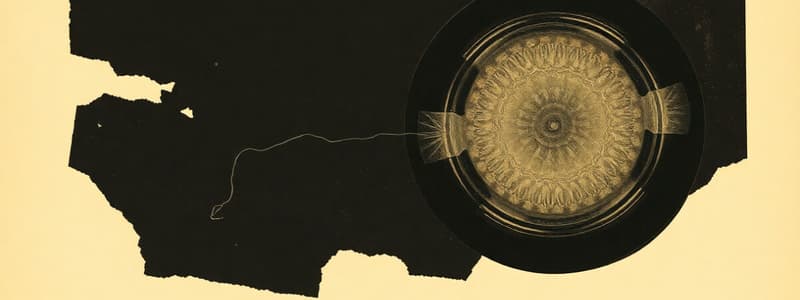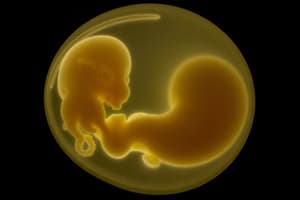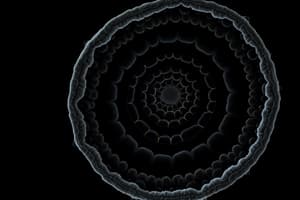Podcast
Questions and Answers
What role does the primary yolk sac play during early development?
What role does the primary yolk sac play during early development?
What process does the hypoblast primarily help to prepare for?
What process does the hypoblast primarily help to prepare for?
Which of the following conditions is associated with abnormalities in laterality?
Which of the following conditions is associated with abnormalities in laterality?
What is the primary function of the amniotic cavity that forms above the epiblast?
What is the primary function of the amniotic cavity that forms above the epiblast?
Signup and view all the answers
What is established by the enlarged irregular yolk sac during early development?
What is established by the enlarged irregular yolk sac during early development?
Signup and view all the answers
Which of the following structures is formed by the hypoblast?
Which of the following structures is formed by the hypoblast?
Signup and view all the answers
Which of the following developmental stages does the hypoblast influence?
Which of the following developmental stages does the hypoblast influence?
Signup and view all the answers
What is the significance of the primitive streak in embryonic development?
What is the significance of the primitive streak in embryonic development?
Signup and view all the answers
Which cells are the first to migrate through the primitive streak during gastrulation?
Which cells are the first to migrate through the primitive streak during gastrulation?
Signup and view all the answers
What does the mesoderm develop into during embryonic development?
What does the mesoderm develop into during embryonic development?
Signup and view all the answers
How does gastrulation influence the future placement of cells in the body?
How does gastrulation influence the future placement of cells in the body?
Signup and view all the answers
Which germ layer gives rise to the central and peripheral nervous systems?
Which germ layer gives rise to the central and peripheral nervous systems?
Signup and view all the answers
During the formation of the amniotic cavity, which layer contributes primarily to its development?
During the formation of the amniotic cavity, which layer contributes primarily to its development?
Signup and view all the answers
What type of cells does the endoderm layer primarily give rise to?
What type of cells does the endoderm layer primarily give rise to?
Signup and view all the answers
Which of the following statements about the significance of gastrulation is false?
Which of the following statements about the significance of gastrulation is false?
Signup and view all the answers
What abnormality in amniotic fluid volume is characterized by too little fluid?
What abnormality in amniotic fluid volume is characterized by too little fluid?
Signup and view all the answers
Which layer do the amnioblasts that form the amniotic membrane come from?
Which layer do the amnioblasts that form the amniotic membrane come from?
Signup and view all the answers
What is one of the primary functions of the amniotic fluid?
What is one of the primary functions of the amniotic fluid?
Signup and view all the answers
During which days of gestation does the formation of the amniotic cavity occur?
During which days of gestation does the formation of the amniotic cavity occur?
Signup and view all the answers
What term describes an excessive amount of amniotic fluid?
What term describes an excessive amount of amniotic fluid?
Signup and view all the answers
Which of the following is NOT a function of the amniotic cavity?
Which of the following is NOT a function of the amniotic cavity?
Signup and view all the answers
What embryological structure forms a crucial part of the body plan during early development?
What embryological structure forms a crucial part of the body plan during early development?
Signup and view all the answers
What is the state of the amniotic cavity immediately before the formation occurs?
What is the state of the amniotic cavity immediately before the formation occurs?
Signup and view all the answers
Which complication may arise from oligohydramnios?
Which complication may arise from oligohydramnios?
Signup and view all the answers
The embryonic disc is described as a:
The embryonic disc is described as a:
Signup and view all the answers
What complication is most likely associated with an irregular chorionic sac and abnormal trophoblast invasion?
What complication is most likely associated with an irregular chorionic sac and abnormal trophoblast invasion?
Signup and view all the answers
Which of the following germ layers is derived from the bilaminar disc?
Which of the following germ layers is derived from the bilaminar disc?
Signup and view all the answers
What is a possible consequence of oligohydramnios during pregnancy?
What is a possible consequence of oligohydramnios during pregnancy?
Signup and view all the answers
What condition is characterized by excessive amniotic fluid?
What condition is characterized by excessive amniotic fluid?
Signup and view all the answers
Which structure primarily provides cushioning and a stable environment for developing embryos?
Which structure primarily provides cushioning and a stable environment for developing embryos?
Signup and view all the answers
Which germ layer is responsible for forming the nervous system?
Which germ layer is responsible for forming the nervous system?
Signup and view all the answers
Which complication may arise from preterm labor?
Which complication may arise from preterm labor?
Signup and view all the answers
What critical event occurs during the third week of gestation?
What critical event occurs during the third week of gestation?
Signup and view all the answers
What is one of the potential risks associated with the presence of a molar pregnancy?
What is one of the potential risks associated with the presence of a molar pregnancy?
Signup and view all the answers
Which germ layer is primarily associated with forming muscles and bones?
Which germ layer is primarily associated with forming muscles and bones?
Signup and view all the answers
What condition might be indicated by a bilaminar disc during days 8-9 of development?
What condition might be indicated by a bilaminar disc during days 8-9 of development?
Signup and view all the answers
Which statement about the yolk sac is accurate?
Which statement about the yolk sac is accurate?
Signup and view all the answers
Which germ layer is associated with the development of the gastrointestinal tract and liver?
Which germ layer is associated with the development of the gastrointestinal tract and liver?
Signup and view all the answers
What is a major characteristic of skeletal dysplasia in relation to embryonic development?
What is a major characteristic of skeletal dysplasia in relation to embryonic development?
Signup and view all the answers
What is a potential consequence of errors in the formation of the embryonic disc?
What is a potential consequence of errors in the formation of the embryonic disc?
Signup and view all the answers
What does the trilaminar disc consist of?
What does the trilaminar disc consist of?
Signup and view all the answers
How do the germ layers of the embryonic disc contribute to development?
How do the germ layers of the embryonic disc contribute to development?
Signup and view all the answers
What role does the bilaminar disc play in embryonic development?
What role does the bilaminar disc play in embryonic development?
Signup and view all the answers
What is the primary function of the embryonic disc during early development?
What is the primary function of the embryonic disc during early development?
Signup and view all the answers
Which stage is known for the complex processes that form tissues and organs of the developing embryo?
Which stage is known for the complex processes that form tissues and organs of the developing embryo?
Signup and view all the answers
Flashcards
Primitive Streak
Primitive Streak
A structure that forms along the midline of the epiblast during gastrulation, extending from the posterior to anterior end of the embryo. It determines the body's left-right and head-to-tail axis.
Cell Migration and Layer Formation
Cell Migration and Layer Formation
The process by which epiblast cells migrate inward through the primitive streak, forming the three germ layers (ectoderm, mesoderm, and endoderm).
Ectoderm
Ectoderm
The outermost germ layer that develops into the nervous system, skin, and sense organs.
Mesoderm
Mesoderm
Signup and view all the flashcards
Endoderm
Endoderm
Signup and view all the flashcards
Gastrulation
Gastrulation
Signup and view all the flashcards
Amniotic Cavity
Amniotic Cavity
Signup and view all the flashcards
Implantation
Implantation
Signup and view all the flashcards
What is the amniotic cavity?
What is the amniotic cavity?
Signup and view all the flashcards
What is the amnion?
What is the amnion?
Signup and view all the flashcards
What is oligohydramnios?
What is oligohydramnios?
Signup and view all the flashcards
What is polyhydramnios?
What is polyhydramnios?
Signup and view all the flashcards
What is the function of amniotic fluid?
What is the function of amniotic fluid?
Signup and view all the flashcards
How does amniotic fluid regulate temperature and hydration?
How does amniotic fluid regulate temperature and hydration?
Signup and view all the flashcards
How does amniotic fluid promote movement?
How does amniotic fluid promote movement?
Signup and view all the flashcards
What is the embryonic disc?
What is the embryonic disc?
Signup and view all the flashcards
What are the layers of the embryonic disc?
What are the layers of the embryonic disc?
Signup and view all the flashcards
When does the embryonic disc form?
When does the embryonic disc form?
Signup and view all the flashcards
Bilaminar Disc
Bilaminar Disc
Signup and view all the flashcards
Trilaminar Disc
Trilaminar Disc
Signup and view all the flashcards
Embryonic Disc
Embryonic Disc
Signup and view all the flashcards
Umbilical Vesicle (Yolk Sac)
Umbilical Vesicle (Yolk Sac)
Signup and view all the flashcards
Molar Pregnancy
Molar Pregnancy
Signup and view all the flashcards
Placenta Accreta
Placenta Accreta
Signup and view all the flashcards
Ectopic Pregnancy
Ectopic Pregnancy
Signup and view all the flashcards
Oligohydramnios
Oligohydramnios
Signup and view all the flashcards
Polyhydramnios
Polyhydramnios
Signup and view all the flashcards
Hypoblast
Hypoblast
Signup and view all the flashcards
Enlarged irregular yolk sac
Enlarged irregular yolk sac
Signup and view all the flashcards
Dorsal-ventral polarity
Dorsal-ventral polarity
Signup and view all the flashcards
Prepares for gastrulation
Prepares for gastrulation
Signup and view all the flashcards
Laterality Disorder
Laterality Disorder
Signup and view all the flashcards
Situs Inversus
Situs Inversus
Signup and view all the flashcards
Study Notes
Bilaminar Disc Formation
- Occurs around days 8-9 post-fertilization
- Embryoblast differentiates into two distinct layers
- Creates a flat, two-layered structure called the bilaminar embryonic disc
- Establishes the basis for the embryo's body plan
- Precursor to more complex differentiation
Two Layers of the Bilaminar Disc
- Epiblast: Columnar cells on the dorsal side, crucial for the entire embryo proper and all three germ layers (ectoderm, mesoderm, and endoderm).
- Hypoblast: Layer of cuboidal cells on the ventral side, part of extraembryonic structures like the yolk sac, but not the embryo itself.
Associated Structures
- Amniotic Cavity: Forms within the epiblast layer, expanding to surround the embryo providing a cushion.
- Primary Umbilical Vesicle (Primary Yolk Sac): Formed by hypoblast-derived cells, site of initial nutrient exchange and hematopoiesis.
Importance of Bilaminar Disc Formation
- Establishes dorsal-ventral polarity in the embryo
- Prepares the embryo for gastrulation, the next crucial developmental stage
Gastrulation (Trilaminar Disc Formation)
- A transformative phase (around days 14-16)
- Converts the bilaminar disc into a trilaminar disc with three primary germ layers: ectoderm, mesoderm, and endoderm
- Marks the beginning of the embryo's structural complexity and organization
- Each germ layer develops into specific tissues and organs
Key Steps in Gastrulation: Primitive Streak Formation
- A structure called the primitive streak emerges along the midline of the epiblast
Studying That Suits You
Use AI to generate personalized quizzes and flashcards to suit your learning preferences.
Related Documents
Description
This quiz delves into the formation of the bilaminar disc around days 8-9 post-fertilization. It covers the differentiation of the embryoblast into the epiblast and hypoblast layers and their roles in embryonic development. Additionally, it highlights associated structures crucial for establishing the embryo's body plan.




